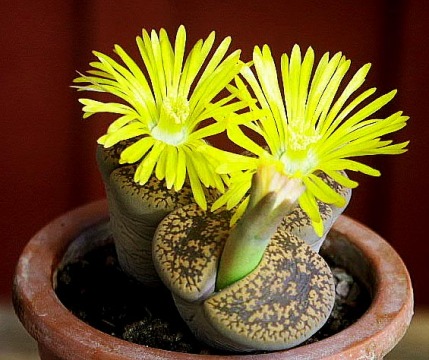Lithops is a part of the Mesembryanthemaceae family consisting of 200 species native to South America and Namibia. The blooming period of the plant begins in autumn or at the beginning of winter.
Lithops looks a lot like a living stone that has in its composition two leaves ready to detect and absorb any source of water existing in the atmosphere. This transformation of the leaves comes as a result of the natural habitat in which the plant grows and, as the rain is almost lacking, the water conservation is very important.
The flowers produced by Lithops are similar in terms of aspect with the dandelions and have colors such as yellow or white depending on the species. 
Lithops is an ideal garden plant. Even though the growing process demands favorable conditions and the plant grows relatively slow, by combining the different existing species of Lithops, your garden will most definitely have an original, diversified look given by the varied palette of colors available in the case of leaves.
If you consider growing Lithops as an interior plant, you should take great attention in the quantities of water that you administrate. The watering process is very important and has a lot to do with the long period that it needs in order to grow. If not paying attention to the watering process, Lithops will need years to reach maturity and the excess will most definitely kill the plant. Pay attention also at the periods of watering as it is forbidden to do this at the beginning of October or during winter and spring.
When talking about planting Lithops it can be used any type of compost mixed with a bit of sand and, regarding fertilization, the process shouldn’t be repeated too often, as Lithops is a plant that needs a small quantity of nutrients.
The flowering process depends on the quantity of light the plant receives during spring and summer but it is also important to know that too much sun will actually burn the plant.
Lithops Pictures Gallery




